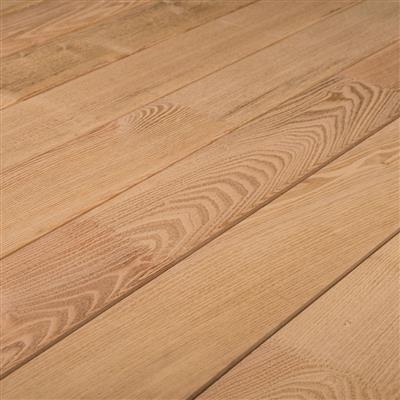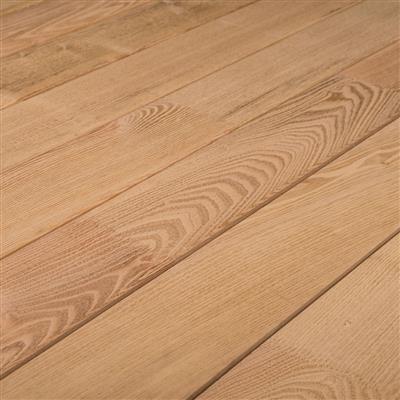Decking Boards Black Locust unsteamed fj | 6000x118x23 mm | smooth/planed
The wood species robinia (Robinia pseudoacacia) has excellent properties for outdoor use.
The robinia tree also known as white robinia, false acacia or false acacia is a deciduous deciduous tree. The robinia tree originated in eastern North America. In the meantime, the tree species has become established worldwide and is also cultivated in plantations. In total, the black locust is the third largest deciduous tree from plantations worldwide, with almost 2 million hectares. It owes its name to a French gardener, Jean Robin, court gardener in Paris, who cultivated the tree in France at the beginning of the 17th century. The American name is "Black Locust", which means "black grasshopper". This is because the dried legumes that remain on the tree for a long time after the leaves fall are somehow reminiscent of locusts. The tree is fast-growing, reaching heights of up to about 30 m and diameters of up to about 30 to 40 cm. The stem is usually crooked. The bark is thin and forms a deep reticulated bark of grey-brown colour early on. The durability class is durable to very durable (1-2). The wood is very resistant to fungi and insects.
Robinia has a wide colour spectrum from greenish-yellow to light brown-golden brown. The sapwood is narrow and yellowish. The wood bleeds out moderately, i.e. coloured wood substances are washed out.
Grading and special features
Our finger jointed Robinia decking boards are re-sorted, i.e. 1st and 2nd choice without quantity information on distribution. However, the following wood-typical characteristics and peculiarities are not considered grounds for complaint: dry cracks, surface cracks, end cracks, knots, discolouration, alternating growth, resin galls, resin leakage and "pinholes" (frass channels caused by fresh wood insects, but without influence on the durability or static properties).
Water or mould stains on the wood caused by storage or transport will disappear completely after a short time due to UV radiation or when the decking boards are oiled. Before installation, always store the decking boards in a well-ventilated, dry place stacked on squared timber but without a foil cover. Decking boards are not cut at right angles and to size on delivery and must always be cut neatly to the final size during installation.
Surface
We always recommend a smooth surface. Smoothly planed surfaces have advantages over finely grooved, coarsely grooved or grooved surfaces. A smooth surface is not more slippery, dries faster, is easier to clean, water can run off better and no moss forms or dirt accumulates in the grooves as with a grooved surface. With smooth surfaces, you can usually use both sides depending on your taste. Please note that one side is usually only levelled, i.e. partially not planed out cleanly over the entire length. Smooth decking boards can always be sanded or sanded if necessary or desired. This way you can repair slight damages or renew the entire terrace if it has turned grey after a few years.
Assembly
The installation must be carried out professionally, i.e. maximum distance of the substructure approx. 45-50 cm, terrace must be well ventilated, prevention of waterlogging by constructive wood protection. Please use only fastening materials made of stainless steel (V2A or V4A) for installation. Simple fastening materials that are only galvanised react with the ingredients of the wood and lead to unsightly, usually dark discolouration. If the screws are visible, the holes must be pre-drilled to avoid cracks and splintering due to the tension in the wood. Treat the decking boards with an end-grain wood preservative at the ends to prevent drying-related cracks at the board ends.
Cleaning & Maintenance
Your decking is alive! Wood is a natural material and reacts to the influences of nature. Clean your decking boards once a year with an intensive cleaner and a brush to prevent the formation of moss and algae and to keep the surface a beautiful silver-grey. After the basic cleaning, we recommend treating your terrace with a special outdoor oil. You saturate the fibres with the oil and thus the moisture absorption in the wood is reduced. The wood swells and shrinks less. Regular oil treatment prevents the formation of cracks in the boards, which can occur with strong temperature fluctuations.
| Category | Garden |
| Product group | Wooden decking boards |
| Lengths | 6000 mm |
| Widths | 118 mm |
| Thicknesses | 23 mm |
| Weight kg/m2 | 16.500 |
| Specie | Black Locust unsteamed |
| Botanical name | Robinia pseudoacacia |
| Wood type | Hardwood |
| Wood origin | Romania | Central Europe | Southeastern Europe |
| Manufacturing/origin | Romania |
| Certification | not certified |
| Colour | light-brown |
| Hue | medium colour |
| Durability class | 1 / very durable, over 25 years |
| Profile | smooth/equalized in the thickness |
| Groove laterally | no |
| Construction | solid |
| Selection | standard unsorted, A/B/C (contains all sorts without a specific ratio) |
| Wood bleeding | medium |
| Surface structure | planed |
| Surface treatment | untreated |
| Humidity | 16% ± 4% |
| Customs tariff number | 44079980 |
| Packaging | loosely |
| Items on stock | yes |
| Date of delivery | approx. 3 - 6 working days |
| Postal shipping | nein |

 Deutsch
Deutsch
 Français
Français
 Italiano
Italiano























